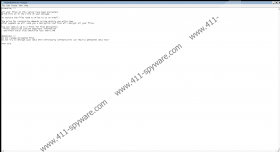Blitzkrieg Ransomware Removal Guide
If you do not want to jeopardize your operating system and your personal files, you need to keep Blitzkrieg Ransomware away. This malicious threat might try to invade your Windows operating system via spam emails and using remote-access vulnerabilities, and if you do not prevent it from slithering in, your operating system could crash, and all your personal files could be lost. To keep this malicious threat away, practicing carefulness online is not the only thing you want to do. You also want to backup your personal files, so that if malware slithers in and corrupts files, you have backups to fall onto. Finally, and probably most importantly, you need reliable security software to assist you. This software will run in the background without disturbing you to warn you about threats and remove them before they are executed. If you already need to delete Blitzkrieg Ransomware, these security measures might seem unimportant, but you should not forget about them once you eliminate the infection.
After execution, Blitzkrieg Ransomware encrypts files immediately, and, according to our malware experts, it can corrupt all files it comes across. Most infections of this kind – for example, CuteRansom Ransomware and GetCrypt Ransomware – encrypt personal files because they cannot be replaced (unless backups exist) and victims are more likely to follow the attackers’ instructions to get them back. Blitzkrieg Ransomware, however, can encrypt system files too, and that could cause it to crash or work disorderly. If your system crashes, you might not get the chance to face “HowToBackFiles.txt,” a ransom note file created by the threat. This causes big problems for you, but it also causes problems for the attackers because if they cannot get their message delivered to the victims, they cannot be successful. The goal of the attack is to make victims pay a ransom in return for an alleged decryptor, and how can they demand that when the system crashes? This is not the only thing that makes us doubt the overall functionality of the infection. One version of this malware displays a message that makes paying the ransom impossible, and so it seems that this malware is either created by amateurs or is unfinished still.
Yes, there are a few different version of Blitzkrieg Ransomware, and it seems like the original one is the more functional one. That is because when the ransom note file includes an email address that the victims are urged to use to contact the attackers. If you send a message to Blitzkriegpc@protonmail.com, you should receive information on how to pay a ransom because the ransom note does not reveal the sum of the ransom, and it does not explain how it must be paid, which means that the email address is important. The second version of the infection leaves the email section blank, which is why we assume that this version is still being built. This is not the only difference between the two versions, as the original one appends “.bkc” extension to the corrupted files, while the more recent version appends “.non”. In either case, your files are encrypted, and you are unlikely to get them back, even if you pay the ransom, as cyber criminals and their promises cannot be trusted.
If your system does not run in a normal manner, you might have no other option but to reinstall Windows. If you cannot do that on your own, seek help from a more experienced friend or a professional. Once the system is reinstalled, you will not need to remove Blitzkrieg Ransomware. In fact, even if your system runs smoothly, and only personal files are encrypted, it seems that this threat is set to remove itself. Of course, we already know that this malware is quite dysfunctional, and so it would not be too surprising to learn that it persists after successful encryption. Since the file could be dropped anywhere with a random name, deleting Blitzkrieg Ransomware manually might be very difficult. The good news is that you can always use anti-malware software. The best part about this software is that once it erases malware, it can silently protect your system against attackers in the future.
How to delete Blitzkrieg Ransomware
N.B. Even though the ransomware should remove itself, you need to examine your operating system to make sure that malware components do not remain active.
- If the malicious .exe file that executed the threat still exists, Delete it ASAP.
- Delete the file named HowToBackFiles.txt. Do the same with all other copies.
- Empty Recycle Bin and then inspect your operating system using a legitimate malware scanner.
Blitzkrieg Ransomware Screenshots:


